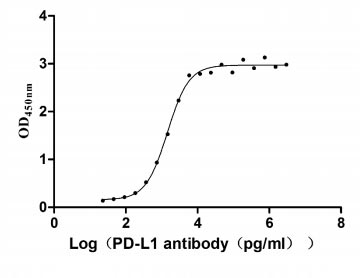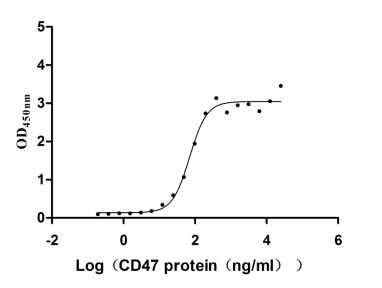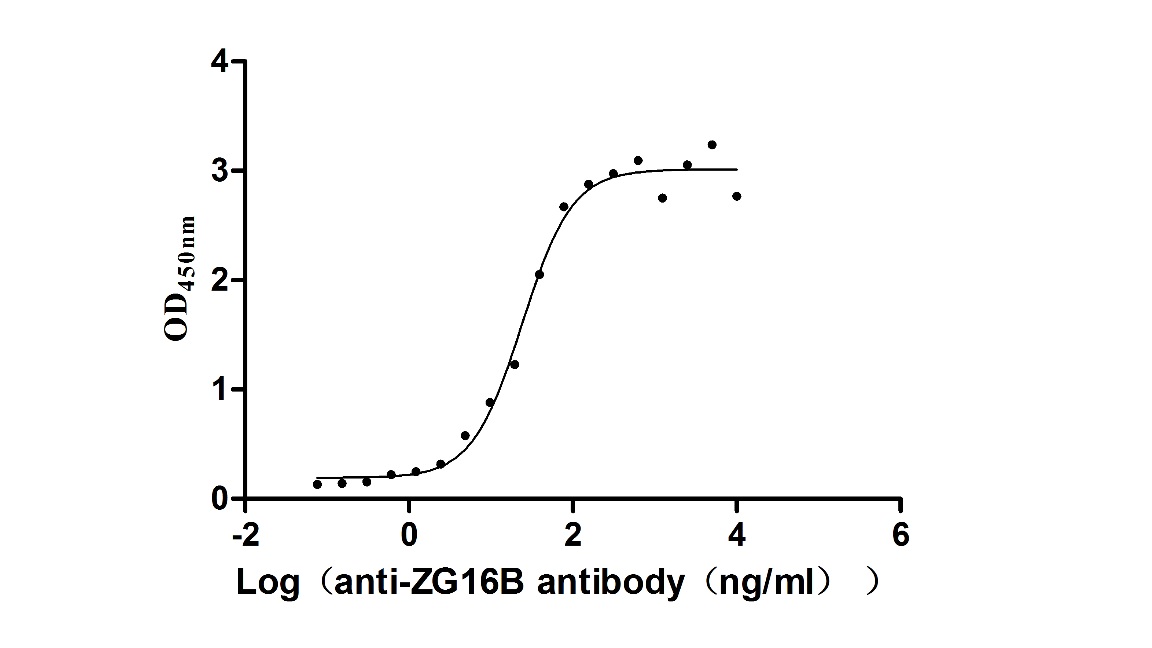Recombinant Mouse Tumor necrosis factor ligand superfamily member 9 (Tnfsf9), partial
-
中文名称:小鼠Tnfsf9重组蛋白
-
货号:CSB-YP023997MO1
-
规格:
-
来源:Yeast
-
其他:
-
中文名称:小鼠Tnfsf9重组蛋白
-
货号:CSB-EP023997MO1
-
规格:
-
来源:E.coli
-
其他:
-
中文名称:小鼠Tnfsf9重组蛋白
-
货号:CSB-EP023997MO1-B
-
规格:
-
来源:E.coli
-
共轭:Avi-tag Biotinylated
E. coli biotin ligase (BirA) is highly specific in covalently attaching biotin to the 15 amino acid AviTag peptide. This recombinant protein was biotinylated in vivo by AviTag-BirA technology, which method is BriA catalyzes amide linkage between the biotin and the specific lysine of the AviTag.
-
其他:
-
中文名称:小鼠Tnfsf9重组蛋白
-
货号:CSB-BP023997MO1
-
规格:
-
来源:Baculovirus
-
其他:
-
中文名称:小鼠Tnfsf9重组蛋白
-
货号:CSB-MP023997MO1
-
规格:
-
来源:Mammalian cell
-
其他:
产品详情
-
纯度:>85% (SDS-PAGE)
-
基因名:
-
Uniprot No.:
-
别名:Tnfsf9; Cd137l; Cd157l; Ly63l; Tumor necrosis factor ligand superfamily member 9; 4-1BB ligand; 4-1BBL
-
种属:Mus musculus (Mouse)
-
蛋白长度:Partial
-
蛋白标签:Tag type will be determined during the manufacturing process.
The tag type will be determined during production process. If you have specified tag type, please tell us and we will develop the specified tag preferentially. -
产品提供形式:Lyophilized powder
Note: We will preferentially ship the format that we have in stock, however, if you have any special requirement for the format, please remark your requirement when placing the order, we will prepare according to your demand. -
复溶:We recommend that this vial be briefly centrifuged prior to opening to bring the contents to the bottom. Please reconstitute protein in deionized sterile water to a concentration of 0.1-1.0 mg/mL.We recommend to add 5-50% of glycerol (final concentration) and aliquot for long-term storage at -20℃/-80℃. Our default final concentration of glycerol is 50%. Customers could use it as reference.
-
储存条件:Store at -20°C/-80°C upon receipt, aliquoting is necessary for mutiple use. Avoid repeated freeze-thaw cycles.
-
保质期:The shelf life is related to many factors, storage state, buffer ingredients, storage temperature and the stability of the protein itself.
Generally, the shelf life of liquid form is 6 months at -20°C/-80°C. The shelf life of lyophilized form is 12 months at -20°C/-80°C. -
货期:Delivery time may differ from different purchasing way or location, please kindly consult your local distributors for specific delivery time.Note: All of our proteins are default shipped with normal blue ice packs, if you request to ship with dry ice, please communicate with us in advance and extra fees will be charged.
-
注意事项:Repeated freezing and thawing is not recommended. Store working aliquots at 4°C for up to one week.
-
Datasheet :Please contact us to get it.
相关产品
靶点详情
-
功能:Cytokine that binds to TNFRSF9. Induces the proliferation of activated peripheral blood T-cells. May have a role in activation-induced cell death (AICD). May play a role in cognate interactions between T-cells and B-cells/macrophages.
-
基因功能参考文献:
- this study shows that intrinsic 4-1BB signals are indispensable for the establishment of an influenza-specific tissue-resident memory CD8 T-cell population in the lung PMID: 28051085
- 4-1BBL can restrain effector T cell development, creating a more favorable regulatory T cell to effector cell balance under tolerogenic conditions, and this may be particularly active in mucosal barrier tissues PMID: 25404362
- These results demonstrate that 4-1BBL-engineered DCs can improve CIKs cytotoxicity against prostate cancer cells. PMID: 25572476
- Data indicate that CD137L deficient mice displayed a variety of immunological dysfunctions. PMID: 24091276
- CD137-expressing CD4+ T cells in the bone marrow engage CD137L on hematopoietic progenitor cells, and this CD137L signaling biases hematopoiesis towards myelopoiesis during aging. PMID: 23945137
- Results suggest that CD137L reverse signaling exerts a pro-apoptotic effect by suppressing integrin-mediated survival signals in neural stem cells. PMID: 23925549
- A VCAM-1-positive stromal cell is a plausible candidate for the radioresistant cell that provides 4-1BB ligand to sustain memory CD8-positive T cells. PMID: 22886791
- The CD137L induces tyrosine phosphorylation as well as the up-regulation of M-CSF, IL-1beta and TN-C expressions by knockdown of TMEM126A. PMID: 22885069
- 4-1BB signaling negatively modulate Treg cells by two distinct mechanisms: i) inhibiting the conversion of CD4(+)FoxP3(-) T cells into iTreg cells and ii) endowing Teff cells refractory to inhibition by Treg cells. PMID: 22870329
- The CD137L reverse signaling pathway in epithelial cells may represent a good target for blocking the initial stage of inflammatory diseases, including renal ischemia-reperfusion injury. PMID: 22160719
- Reverse signals initiated by CD137L negatively modulate certain immune functions of thioglycollate-elicited peritoneal macrophages PMID: 21184130
- Mice inoculated with H22 tumor cells expressing B7-1, B7-2 and 4-1BBL developed a strong cytotoxic T lymphocyte response and long-term immunity against wild-type tumor, suggesting a synergistic effect between the B7 and 4-1BBL costimulatory pathways PMID: 20563597
- Cocultures of Natural killer (NK) cells with CD137L transfectants confirmed that human CD137 inhibits NK-cell reactivity, while activating signals were transduced by its counterpart on NK cells in mice. PMID: 20008791
- A role for 4-1BB ligand in dendritic cell activation PMID: 11867564
- In a murine model, herpetic stromal keratitis is inhibited by blockade of 4-1BBL/4-1BB interactions with monoclonal antibodies to 4-1BBL or by deletion of 4-1BB. PMID: 12847221
- involvement of 4-1BB in CD4(+) Th1 cell responses by regulating the clonal expansion and survival of CD4(+) T cells as seen in CD8(+) T cells PMID: 14749528
- Characterization of the role of 4-1BBL in activation and recall response of CD4 T cells vs CD8 T cells. PMID: 14991604
- demonstrate that suppression of experimental autoimmune uveoretinitis results from antigen-driven, 4-1BB-mediated expansion of novel CD11c+CD8+ T cells that suppress antigen-specific CD4+ T cells via an indole 2,3-dioxygenase-dependent mechanism PMID: 16899371
- indicate that the CD28 costimulatory pathway plays a major role in the alloimmune response and that 4-1BB signals are dependent upon CD28 signals PMID: 17202836
- IL-13 was coinduced following 4-1BB triggering to maintain the Th1/2 balance of immune response. PMID: 17389581
- Thus, long-term inhibition of the 4-1BB pathway reduces cardiac damage, remodeling, and inflammation during viral myocarditis. PMID: 17468777
- CD137 ligand plays a role in allergic asthma. PMID: 17845419
- CD80 and 4-1BBL induce auto- and transcostimulation in tumor cells PMID: 18026115
- deliver new insights into the multiple effects of reverse signaling of CD137L in human DC during the initiation of an adaptive immune response PMID: 18395851
- IL12- and CD137L-transfected plasmocytoma cells prevented tumor growth and induced long-lasting immunity PMID: 18610746
- Reverse CD137 ligand signaling takes place in hematopoietic progenitor cells, where it induces proliferation and differentiation toward monocytes and macrophages. PMID: 18768847
- modification of cancer cells with 4-1BBL gene can produce anti-tumor immune responses. PMID: 18954562
- During mild respiratory influenza infection in which virus is rapidly cleared, costimulatory receptor 4-1BB is transiently induced on lung T cells and 4-1BB ligand (4-1BBL) is completely dispensable for the initial CD8 T cell response and mouse survival. PMID: 19124736
- 41BBL requires hexamerization for activation PMID: 19596991
- CD137L ordinarily regulates the GC B-cell response and thereby acts as a tumor suppressor. PMID: 19608748
- These findings demonstrate that reverse signals evoked by CD137L regulate immune functions in macrophages. PMID: 19676073
- 4-1BB ligand induces cell division, sustains survival, and enhances effector functions of CD4 and CD8 T cells under comparable conditions of antigenic stimulation. PMID: 11466348
显示更多
收起更多
-
亚细胞定位:Membrane; Single-pass type II membrane protein.
-
蛋白家族:Tumor necrosis factor family
-
数据库链接:
KEGG: mmu:21950
STRING: 10090.ENSMUSP00000040412
UniGene: Mm.41171
Most popular with customers
-
Recombinant Human Programmed cell death 1 ligand 1 (CD274), partial (Active)
Express system: Mammalian cell
Species: Homo sapiens (Human)
-
Express system: Mammalian cell
Species: Homo sapiens (Human)
-
Recombinant Macaca fascicularis zymogen granule protein 16 homolog B (ZG16B) (Active)
Express system: Mammalian cell
Species: Macaca fascicularis (Crab-eating macaque) (Cynomolgus monkey)
-
Recombinant Rat Gastric inhibitory polypeptide receptor (Gipr), partial (Active)
Express system: Mammalian cell
Species: Rattus norvegicus (Rat)
-
Recombinant Human Myosin regulatory light chain 12A (MYL12A) (Active)
Express system: E.coli
Species: Homo sapiens (Human)

















